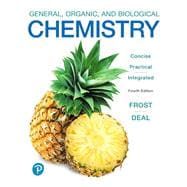About This Book
General, Organic, and Biological Chemistry, 4th Edition
ISBN: 9780134988696
General, Organic, and Biological Chemistry, 4th Edition, is a comprehensive textbook designed for one-semester courses in general, organic, and biological chemistry. This book is a go-to resource for students and educators alike, offering a detailed exploration of the fundamental connections between chemistry and life.
Who Uses It?
Primarily, this book is used by students and instructors in introductory general, organic, and biological chemistry courses at the college and university levels. It's also a valuable resource for allied-health and non-science majors looking to understand the practical applications of chemistry in future health professions and everyday life.
History and Editions
The 4th edition of General, Organic, and Biological Chemistry has been updated to strengthen the integrated approach of general, organic, and biological chemistry. This edition includes a streamlined approach that establishes a clear path through the content over a single semester. The text integrates essential topics more effectively than any other text on the market, covering core concepts in each discipline in just 12 comprehensive chapters[1][2].
Author and Other Works
The authors of General, Organic, and Biological Chemistry are Laura Frost and S. Deal. While specific details about their other works are not readily available, the book reflects their expertise in integrating general, organic, and biological chemistry for a focused introduction to the fundamental connections between chemistry and life.
Key Features
- Integrated Approach: The book integrates essential topics in general, organic, and biological chemistry, providing a clear path through the content over a single semester.
- Comprehensive Coverage: The text covers core concepts in each discipline in just 12 comprehensive chapters.
- Practical Applications: The applied focus provides allied-health and non-science majors with practical applications for understanding chemistry in future health professions and everyday life.
- Mastering Chemistry: While Mastering Chemistry does not come packaged with this content, students can purchase the package that includes both the physical text and Mastering Chemistry for enhanced learning experiences[1][2].
Detailed Information
ISBNs and Formats
- Hardcover: ISBN-13: 9780134988696
- eBook: Available through various retailers
- Rental Options: Various rental durations available from different retailers
Publication Details
- Publisher: Pearson
- Publication Date: January 4, 2019
- Number of Pages: 560 pages
- Language: English
- Item Weight: Not specified
- Dimensions: Not specified
Related ISBNs
- General, Organic, and Biological Chemistry Plus Mastering Chemistry with Pearson eText -- Access Card Package: ISBN-13: 9780134990804
- Mastering Chemistry with Pearson eText -- ValuePack Access Card -- for General, Organic, and Biological Chemistry: ISBN-13: 9780134990088
Additional Resources
For students interested in purchasing both the physical text and Mastering Chemistry, they should search for the package that includes both components. Instructors can contact their Pearson representative for more information on how to integrate this resource into their course materials[1][2].
This detailed information section provides a quick reference for all the available formats and sources for General, Organic, and Biological Chemistry, 4th Edition, making it easier to find and access the book in the preferred format.









